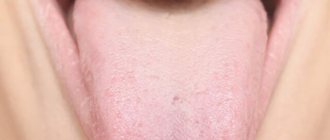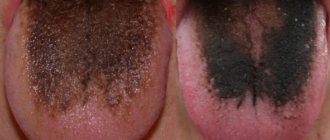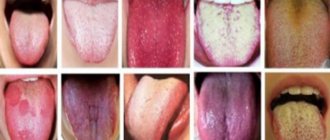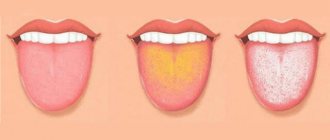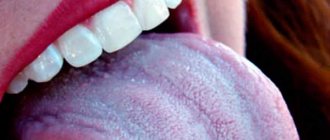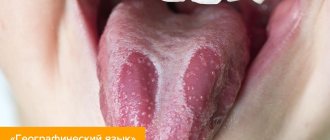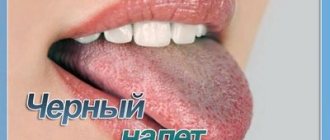The norm is a small formation of light or white color. But a yellow coating on the tongue and bitterness already indicate disturbances in the functioning of the body.
Any changes in the oral cavity are always scary and cause discomfort. A slight coating on the tongue is normal for both adults and children. However, if the formation has acquired an atypical hue and is accompanied by bitterness, then this may indicate signs of illness.
What kind of coating on the tongue indicates health problems?
If there is a thickening of the plaque, a change in its color and the appearance of an unpleasant odor from the mouth , this is already the result of the activity of bacteria and fungi. Of course, the body is not a sterile substance and microorganisms are always present in it, but the immunity of a healthy child controls their numbers. When immunity decreases or any disease occurs, there is a significant increase in pathogenic bacteria and fungi, which is accompanied by the formation of plaque on the child’s tongue.
Causes of plaque on the tongue
There are many reasons why various plaques may appear on the tongue: from the banal consumption of foods that can change the color of the tongue, to serious health problems that require immediate medical attention.
Read also: Computer anesthesia STA – dentistry WITHOUT PAIN!
The very first thing you need to do when you discover strange coatings on a child’s tongue is to remember what the baby ate in the last 24 hours. Very often, sweet carbonated drinks, caramels or other sweets contain active dyes that can give the oral mucosa the most exotic shades: crimson, purple, green, orange and others. Even natural berries and fruits can radically change the color of the tongue. Therefore, there is no need to panic right away. You should ask the child to brush his teeth and tongue, and then evaluate their condition and color. If the plaque has not changed or has reappeared without connection with food intake, then this is a reason to urgently visit your pediatrician.
Yellow tongue in children
Yellow spots on a child’s tongue indicate a gastrointestinal disease.
In children, disruption of the gastrointestinal tract may also be accompanied by yellow spots on the tongue.
Symptoms of the disease also include painful abdominal cramps, nausea, the child’s reluctance to eat, constipation or, conversely, diarrhea.
Eating excessive amounts of food and consuming fatty foods overloads the digestive system of children, so after several hours of overeating, the child begins to feel a dry mouth, feels nauseous, and the tongue becomes covered with a layer of yellow plaque.
- Just like in adults, infections accompanied by fever also affect the condition of the tongue.
- Sudden changes in body temperature, vomiting and stool disturbances are a source of plaque with a brownish tint due to drying out of the mucous membrane and cracking of the tongue, which is accompanied by microbleeding.
- In case of poisoning, the tongue becomes coated due to increased load on the liver. In such situations, plaque is affected by water deficiency in the body.
- In infantile jaundice, the tongue may also turn yellow. This also applies to such types of jaundice as yellowing of the integument due to hepatitis.
- Lesions of the mucous membrane due to inflammatory processes in the mouth, such as stomatitis, carious tooth decay, give rise to pigmentation of the tongue.
- Kidney failure, diabetes mellitus, and disorders of the immune system disrupt metabolism, thereby promoting the accumulation of waste and toxins, which causes the tongue to become yellow.
White coating on the tongue
White plaque can be found in the oral cavity of a baby most often.
This phenomenon also happens normally when, after a night’s sleep, a thin white coating without an unpleasant odor is found on the tongue, disappearing after hygiene procedures and not causing any discomfort or unpleasant sensations.
The appearance of a dense whitish plaque, which is extremely difficult to remove from the surface of the tongue and does not disappear after brushing your teeth, may indicate problems with the gastrointestinal tract (gastritis, enteritis or dysbacteriosis). This phenomenon is often accompanied by bad breath. In addition, children may present complaints that may indicate gastrointestinal pathology:
- abdominal pain of various localizations;
- bloating;
- stool disorders;
- change in appetite
In order to get rid of such white plaque, it is necessary, first of all, to examine the digestive system and eliminate even the most minor disturbances in its functioning.
Read also: Drilling teeth? NO thanks, we use ICON!
In infants up to 2 months of life, thrush or oral candidiasis is a common occurrence in a nursing mother, especially after taking antibiotics or an error in diet. With this pathology, abundant cheesy white deposits appear on the tongue and cheeks, which are easily removed, and small ulcers are found underneath them. After starting treatment for thrush with antifungal agents and treating the oral cavity with antiseptic solutions, the tongue and other mucous membranes quickly cleanse and regain their previous appearance.
Treatment
Important! Depending on the cause of the formation of yellow plaque, the following treatment approach is used:
- For liver diseases , the child is prescribed choleretic drugs (Allohol, Berberine, Flacumin, Nicodin, Cholelitin, Sorbitol, etc.).
- Preparations for the restoration of liver cells (Heptral, Hepatosan, Essentiale, etc.).
- In case of severe pain, antispasmodics are prescribed (Spazmalgon, No-Shpa, Drotaverine, etc.).
- In case of food poisoning , the child is prescribed medications such as activated carbon, Polysorb, Enterosgel , etc. To normalize the intestinal microflora, Bifidumbacterin, Lactobacterin, Linex , etc. are prescribed. You can replenish the loss of fluid in the body with clean drinking water, green tea, compotes and berries fruit drinks.
- For glossitis , antibacterial drugs from the group of tetracyclines, macrolides, cephalosporins , etc. are recommended
- In case of gastritis , anti-inflammatory drugs, sorbents and heartburn remedies are prescribed . It is also necessary to follow a dietary menu.
- In the presence of enterocolitis, children are prescribed antispasmodics, antibacterial agents, sorbents and prebiotics.
It is worth noting! In this case, it is necessary to maintain oral hygiene (including using a toothbrush with a grooved surface on the back side).
It is important to rinse your mouth with water after each meal, and also limit the consumption of coloring foods and fatty foods.
You can begin treatment only after a preliminary examination, when the doctor prescribes the necessary medications and calculates the safe dosage.
Gray coating on the tongue
A gray coating on the tongue can be a sign of some infectious diseases.
For example, with scarlet fever, on the very first day the mucous membranes become covered with a dirty gray coating, which, starting from the tip of the tongue, gradually disappears and reveals a “raspberry tongue” - enlarged papillae on a bright red background, which is very reminiscent of raspberries.
With diphtheria, gray filmy deposits can be found on the root of the tongue, which are difficult to separate. Such plaques spread to the mucous membranes of the throat, palatine arches and are accompanied by coughing and attacks of suffocation.
Treatment of such infectious diseases is carried out only in a hospital setting. After healing, all plaque on the tongue disappears.
Dehydration in a child can also lead to the formation of a gray coating on the surface of the tongue. At the same time, the mucous membranes look dry and dull. Replenishing the required volume of fluid quickly eliminates this symptom.
Features of consistency and thickness of plaque
The disease can be identified not only by the presence of yellow deposits on the surface of the tongue, but also by the thickness and consistency of such formations .
These features indicate the severity of the pathological process developing in the body of a small patient.
Reference! They also help determine the cause that influenced the occurrence of the symptom.
- A small layer of yellowish deposits that persists for several days warns of the presence of infectious diseases .
- Thick, loose formations indicate fungal infections or the presence of parasitic diseases.
- A thick layer of dry plaque indicates the development of autoimmune diseases.
- Dense and wet deposits present for three days. This indicates disturbances in the functioning of the gastrointestinal tract.
- A yellow patchy coating on the back of the tongue is a sign of liver or kidney problems.
Yellow coating on the tongue
A dense yellow coating on the tongue indicates pathology of the liver or biliary tract.
Often in children, diseases of the biliary system occur without a clear clinical picture, and the presence of bile stagnation can only be suspected by a change in the color of deposits on the mucous membranes of the oral cavity.
If a child has a yellow coating on the tongue , it is necessary to urgently consult a doctor and have an examination of the internal organs and the biochemical composition of the blood.
Read also: Medication sleep - WHAT? For what? HOW?
Carrying out diagnostics
You should know! After detecting signs of yellowness on the surface of the tongue, young parents should contact their pediatrician for an examination.
If during the initial examination the doctor reveals a pathology, in order to make an accurate diagnosis, he can additionally prescribe tests for the baby with the following diagnostic measures:
- taking a swab from the oral cavity for bacterial culture and determining the ratio of pathogenic and beneficial microorganisms;
- donation of urine and feces to determine the condition of the liver, gastrointestinal tract or pancreas;
- ultrasound examination of the digestive organs to check their condition, the presence or absence of inflammatory processes and neoplasms;
- biochemical blood test to assess the functioning of internal organs and the general condition of the body.
Stay up to date! One consultation with a pediatrician when yellow plaque appears in a child is not enough.
To make a diagnosis you may need to visit a specialist such as a gastroenterologist, infectious disease specialist, otolaryngologist, dentist, dermatologist, or toxicologist.
Green coating on the tongue
The appearance of a green coating on the mucous membrane of the tongue often frightens parents, especially if it is found in a newborn or infant.
The most common cause of this phenomenon is candidiasis - a fungal infection of the oral cavity that occurs due to imperfect immune defense in the body of a 1-year-old baby or while taking strong antibacterial drugs.
This plaque has varying color intensities and can spread to other parts of the oral cavity, found on the cheeks, palate and lips. After removing it, you can see the red surface of the tongue with small blisters or ulcers, which cause discomfort to the child.
You should start treating green plaque only after consulting a doctor. Therapeutic measures will consist of taking special drugs with antifungal action and local antiseptics to treat thrush and prevent bacterial complications.
Read also: How bite affects posture and spinal health
Why it appears: reasons
There may be several reasons why a yellow coating appears on the baby’s tongue :
- fungal infection of the oral cavity . Thrush or candidiasis, caused by a fungus of the genus Candida, contributes to the appearance of whitish or yellow deposits that resemble a dense curdled mass;
- autoimmune diseases. They arise as a result of the destruction of the body’s tissues by the body’s own immune system and cause the appearance of many unpleasant symptoms;
- pathologies of the digestive system . Diseases of the stomach and intestines become one of the main reasons for the formation of a yellowish coating on the surface of the baby’s tongue;
- liver diseases . Pathological processes in the bile ducts lead to disruption of the exchange of bile pigment bilirubin, which causes staining of the tongue and skin;
- diabetes. At the initial stage, endocrine-metabolic disease is characterized by the appearance of a yellowish coating, restless behavior and poor weight gain;
- congenital yellowness of the skin and tongue . This is due to the physiological characteristics of the child’s body. Over time, the problem disappears;
- infectious diseases of the ENT organs. A sharp increase in body temperature causes cracking of the tongue and bleeding from small capillaries, which provokes the appearance of plaque;
- low-quality formula for feeding a newborn. Often affects the formation of white or yellow plaque and accompanies the little patient until the parents switch the baby to another formula;
- penetration into the child’s body of toxic substances present in the environment. Toxic substances can also enter the digestive system through mother’s milk;
- parasitic diseases . Toxins produced by helminths or giardia have a negative effect on the child’s body, causing the appearance of a dense yellow plaque.
One of the possible and most common reasons for the formation of yellow deposits in infants is the transition from breastfeeding to artificial feeding .
Keep in mind! In this case, the symptom is temporary.
Brown coating on the tongue
A brown tongue in a child is not such a rare occurrence. There can be many reasons for this:
- Severe diseases of the digestive system , accompanied by inflammatory changes, stagnation of bile in the bile ducts, and disruption of the digestive processes.
- Constant dehydration of the child's body due to high ambient temperatures or insufficient fluid intake.
- Insufficient intake of B
- Taking certain medications : antibiotics, antiseptic solutions, concentrated herbal decoctions.
It is very difficult to establish the exact root cause of the appearance of such a dark plaque. This can only be done by an experienced doctor, who, after additional examinations, will be able to prescribe the optimal treatment.
Black coating on the tongue
The presence of a black coating on a child’s tongue looks quite scary, and there may be several reasons for this phenomenon:
Bacterial sore throat is often accompanied by the appearance of dark plaques on the mucous membranes, even black. In this case, the child will have signs of inflammation in the tonsils: red throat, high fever, pain when swallowing, weakness.
Hidden forms of diabetes mellitus, which lead to persistent disruption of the acid-base balance in the body. Excess acid or acidosis will cause darkening of the tongue.
Taking some antibiotics causes the growth of pathogenic microflora in the mouth, which causes the mucous membranes to become permanently stained black.
Treatment of such plaque will consist of eliminating the causes that caused its appearance. After a sore throat is treated, medications are stopped, or diabetes is identified and compensated for, this symptom will most likely go away on its own.
When is regurgitation considered normal?
Regurgitation is the reflux of gastric contents into the esophagus and oral cavity, which occurs spontaneously after feeding. Doctors say: about 80% of babies are prone to regurgitation. For most, this phenomenon stops by two to three months; extremely rarely it can last up to four to five months. Before this period, two types of regurgitation are considered normal:
- If after feeding the baby burps no more than two teaspoons of formula or milk.
- When during the day there is one regurgitation of stomach contents with a volume of more than three teaspoons.
By the eighth month, physiological (so-called “benign”) regurgitation should completely stop.
Regurgitation is associated with the anatomical features of the structure of the digestive tract in children under 1 year of age. It occurs when air is swallowed into the stomach or when intra-abdominal pressure increases. This may be due to the following factors:
- improper attachment of the baby to the breast;
- lack of feeding regimen, overfeeding;
- active sucking during feeding, while swallowing air;
- incorrect selection of feeding bottles and formula for artificial feeding;
- tight swaddling;
- a sharp change in the baby’s body position immediately after finishing feeding;
- increased gas formation in the intestines.
How can parents of a baby determine the “benign quality” of regurgitation? Physiological regurgitation is characterized by the following factors:
- baby's age up to 1 year;
- regurgitation occurs 2 or more times a day for three or more weeks;
- regurgitation occurs spontaneously, without any specific precursors;
- during regurgitation there is no tension in the muscles of the anterior abdominal wall;
- the baby does not experience difficulty swallowing and feeding, and does not take a forced position;
- regurgitation is not accompanied by increased sweating and pallor of the baby, or a deterioration in his general condition;
- the child is active, has a good appetite, and is gaining weight according to his age.
Physiological regurgitation is also supported by the child’s lack of symptoms of diseases of the central nervous system and digestive organs, and metabolic disorders.
Blue coating on the tongue
A blue tongue is a sign of blood stagnation.
Very often, various diseases of the cardiovascular (congenital heart defects, arrhythmias, heart failure) and nervous system (hemorrhages, cysts, epilepsy) lead to the fact that blood flows through the tissues more slowly than it should - cyanosis or cyanosis appears on the limbs, lips and language. Therefore, if you notice such a symptom in your child, you should urgently contact your doctor for advice.
Read also: Now the beauty and health of your child is completely in your hands
Prevention
In order to prevent the appearance of plaque on a child’s tongue, there are a number of preventive measures that many experts focus on:
- The room in which the child lives should always be clean, well ventilated and humidified.
- You should not prescribe antibiotics to your child yourself. The use of such medications must be strictly justified.
- It is necessary to closely monitor the baby's health. If the slightest symptoms appear that indicate a possible disease from the internal organs, you should urgently seek medical help.
- Limit your child's consumption of sweets containing synthetic coloring pigments: sweet carbonated drinks, candies, chewing gum. This will not only prevent the appearance of active staining of the tongue, but will also preserve the health of delicate children's teeth.
If plaque does appear on the tongue, there is no need to try to remove or treat it yourself. Consult your doctor about the possible causes of this phenomenon and the necessary treatment for it.
Posted in For parents by biglamed
What color should a child's tongue normally be?
In a healthy state, a child’s tongue has a uniformly pink color and a slightly rough surface (due to small papillae, velvety to the touch, that cover the entire surface of the organ).
Normally,
the tongue should be moist and shiny from constantly producing saliva .
Any other deviations indicate some kind of disorder in the body (for example, diseases of the internal organs).
Or they may indicate abuse of harmful and coloring foods.
Among them are black tea, coffee, sweet carbonated drinks, fatty and fried foods, sweets, fast food, etc.
